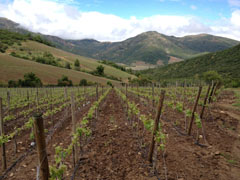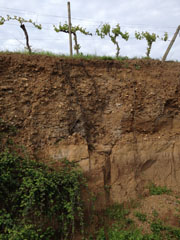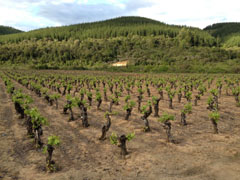Wines of Chile: An Overview
By Kori ~ November 7th, 2012.
 Spanish settlers first planted wine grapes in Chile around 1550. However, the Chilean wine industry really got its start in the 1980’s when Spanish winemaker Miguel Torres arrived in Chile and began making wines in the Curicó Valley. He ushered in a new era of modern winemaking and was the first in Chile to use stainless steel tanks and French oak barrels. Soon other Chilean winemakers followed suit, and the industry has grown exponentially in both vineyard hectares planted and wine sales abroad. So while Chile has a long wine history, I believe that it is just now coming into its own as a world-class wine region.
Spanish settlers first planted wine grapes in Chile around 1550. However, the Chilean wine industry really got its start in the 1980’s when Spanish winemaker Miguel Torres arrived in Chile and began making wines in the Curicó Valley. He ushered in a new era of modern winemaking and was the first in Chile to use stainless steel tanks and French oak barrels. Soon other Chilean winemakers followed suit, and the industry has grown exponentially in both vineyard hectares planted and wine sales abroad. So while Chile has a long wine history, I believe that it is just now coming into its own as a world-class wine region.
During my recent media trip to Chile, I had the pleasure to visit a number of its wineries and vineyards and meet many of the movers and shakers in the Chilean wine industry. In the coming weeks, I will be individually highlighting some of the wine regions we visited including reviews of wines I tasted from those regions. In the meantime, however, I want to give you an overview of those regions so that you get an overall feel for the geography, climate, and wines.
Chilean Wine Regions
Chile’s appellation system, known as its Denomination of Origin or D.O. is divided into the following regions, from north to south:
- Elqui Valley—The Elqui Valley is considered Chile’s northernmost wine region. The valley is hot and dry but also has cool breezes that blow in along the Elqui River. Located in close proximity to the Andes Mountains, the Elqui Valley is best known for producing cool-climate Syrah and Sauvignon Blanc.
- Limarà Valley—Vines were first planted in the Limarà Valley in the mid-16th century. Best known for its Chardonnay, the Limarà Valley also does well with cool-climate Syrah and Sauvignon Blanc.
- Choapa Valley—Located at Chile’s narrowest point, where there is no distinction between the Andes and the Coastal Mountains, the Choapa Valley has a desert-like climate and is best known for its Syrah and Cabernet Sauvignon.
- Aconcagua Valley—The Aconcagua Valley is one of Chile’s most traditional wine growing regions. Named for the tallest mountain in the Americas, the Aconcagua Valley is best known for its Cabernet Sauvignon, Syrah, Carmenere, and coastal Sauvignon Blanc.
- Casablanca Valley—The Casablanca Valley was Chile’s first cool-climate wine region. With its cool Mediterranean climate and pronounced maritime influence, the Casablanca Valley is best known for its Sauvignon Blanc, Chardonnay, and Pinot Noir.
- San Antonio Valley—The San Antonio Valley is a relatively new wine region. Its cool climate is ideal for producing Sauvignon Blanc, Pinot Noir, and Chardonnay.
- Maipo Valley—The Maipo Valley is the closest wine region to the city of Santiago. It spans from the Andes to the coast and is one of Chile’s oldest wine regions. Best known for its red wines, the Maipo Valley does well with Cabernet Sauvignon, Carmenere, and Syrah.
- Cachapoal Valley—The Cachapoal Valley is located in Chile’s agricultural heartland. With its Mediterranean climate, it is best known for producing Cabernet Sauvignon, Merlot, Syrah, and Carmenere.
 Colchagua Valley—One of Chile’s best known wine regions, the Colchagua Valley has received much praise for its full-bodied red wines. Cabernet Sauvignon accounts for more than 40% of all varieties planted, but the Colchagua Valley also does well with Carmenere, Syrah, and Malbec.
Colchagua Valley—One of Chile’s best known wine regions, the Colchagua Valley has received much praise for its full-bodied red wines. Cabernet Sauvignon accounts for more than 40% of all varieties planted, but the Colchagua Valley also does well with Carmenere, Syrah, and Malbec.- Curicó Valley—More than 30 varieties of wine grapes have grown in the Curicó Valley since the mid-1800’s. Its modern winemaking history began when Miguel Torres arrived there over 100 years later. Wine production is one of the area’s most important industries. The Curicó Valley is best known for producing Cabernet Sauvignon, Carmenere, Syrah, and Sauvignon Blanc.
- Maule Valley—The Maule Valley is the largest and one of the oldest wine regions in Chile. A long overlooked region, the Maule Valley is garnering renewed attention. The valley is able to produce a wide variety of wines but is especially known for its Cabernet Sauvignon, Merlot, Carmenere, and old-vine Carignan.
- Itata Valley—The Itata Valley is Chile’s oldest wine region. Its hot summers and very wet, cold winters have posed challenges for most traditional wine grape varieties. The varieties with the most hectares planted are Moscatel de Alejandria and Pais.
- BÃo-BÃo Valley—Average rainfall in the BÃo-BÃo Valley is among the highest of all Chilean wine valleys which makes for more challenging wine growing conditions. Cool-climate varieties such as Sauvignon Blanc, Chardonnay, and Pinot Noir are showing promise there.
- Malleco Valley—The Malleco Valley is currently Chile’s southernmost wine region. High rainfall and a shorter growing season make the area challenging for many varieties, but Chardonnay and Pinot Noir are showing promise.
 Chile is a long, narrow country that runs 2,600 miles along the southwestern coast of South America between the Pacific Ocean and the Andes Mountains. But don’t let its geography fool you, there is more climatic and soil diversity found east to west than from north to south. As a result, Wines of Chile has recently established a New Classification of Chile’s Wine Producing Areas. The New Vitivinicultural Zonification aims to provide consumers with complementary information to give them a better idea of what to expect in a wine so labelled.
Chile is a long, narrow country that runs 2,600 miles along the southwestern coast of South America between the Pacific Ocean and the Andes Mountains. But don’t let its geography fool you, there is more climatic and soil diversity found east to west than from north to south. As a result, Wines of Chile has recently established a New Classification of Chile’s Wine Producing Areas. The New Vitivinicultural Zonification aims to provide consumers with complementary information to give them a better idea of what to expect in a wine so labelled.
New Classification of Chile’s Wine Producing Areas
Wine labels that display a Denomination of Origin can also include the following complementary terms as long as the “sum of at least 85% of the volume of the components of the final blend of the wine come from areas that meet the conditions of the term indicated and that have been declared as such by the Chilean Agriculture and Livestock Service (SAG).â€
- Costa Areas—Costa Areas are cool-climate areas near the Pacific Ocean.
- Entre Cordilleras Areas—Entre Cordilleras Areas are located within the strip of land that runs between the Andes and the Coastal Mountains.
- Andes Areas—Andes Areas are located in close proximity to the Andes Mountains, the longest and most extensive mountain range in the world.
Be sure to come back as I individually highlight some of these Chilean wine regions in the coming weeks.
Salud!
Filed under: Chilean Wine, General Wine Information, Vineyards, Wine Travel

 Wine Peeps is an independent wine blog dedicated to helping you get the most bang for your buck in wine. We do this through blind tastings of wine from around the world and calculations of
Wine Peeps is an independent wine blog dedicated to helping you get the most bang for your buck in wine. We do this through blind tastings of wine from around the world and calculations of 










